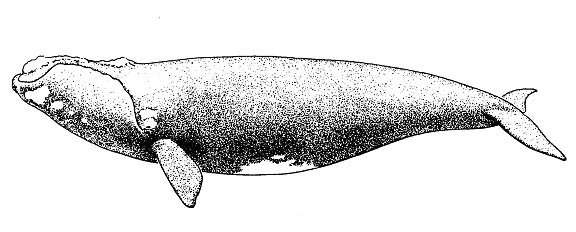
Background
A remarkable event takes place in the coastal waters of northeastern Florida. Each
year from December through March, right whales migrate to this area to give birth and
nurse their calves in warm, protected waters, before again returning north to feeding
grounds off New England and Canada. South of approximately St. Augustine, Florida,
some right whales come in close to shore ? sometimes within a quarter mile of the beach.
Mothers can be seen with young-of-the-year calves, and juvenile whales may be seen
traveling or playing. It is in these waters that a volunteer-based citizen network is
growing and contributing to science, conservation, and stewardship of the species and its
habitat. The Marineland Right Whale Project works along the coastline from the St. Augustine
to Ponce Inlets ? a distance of about 50 nautical miles. The project began in 2001, and now
includes about 200 volunteers.

The North Atlantic right whale, Eubalaena glacialis. This highly endangered species has a total population size of about 500, and gives birth to about 12 calves a year. The calving and nursing occur in coastal waters of northeast Florida from December through March. Adult whales are about 45 ft in length, and the calves about 16 ft. Because of the small numbers and low reproductive rate, protection and stewardship are essential.
In addition to the small population size and low reproductive rate, right whales face an additional challenge: human impacts. Whales become entangled in fishing gear, are struck by vessels, and sometimes are harassed by boaters. Therefore, monitoring of the population in these waters has two principal objectives: 1) mitigating human impacts (ship strikes and gear entanglement), and 2) studying distribution, abundance, demographics, reproduction, behavior, and habitat use so as to enhance conservation and recovery of the species.
Why was the Marineland Right Whale Project established?
Scientists, conservationists, and resource managers are faced with a difficult task. Each year from
December through March, a relatively small number of whales, generally fewer than 100, occur in
a large area (400 nautical miles of coastline from North Carolina to Florida). While near-daily aerial
surveys take place in some areas, they are only partially effective. In other areas, aerial surveys
are few and coverage is poor. The Project's solution to "a small number of whales distributed over
a large area" is to increase the number of eyes looking -- i.e., "if you want to catch more fish, use a
bigger net."
What are the Project's Guiding Principles?
What are the Project's Goals?
What are the Program Components to accomplish these Goals?
During the course of six seasons, the Project's volunteer sighting network has evolved, incorporating refinements and innovation. Currently, a number of interrelated components are essential to the overall success.
What are the Roles of the Project's Volunteers?
The volunteers in the Marineland Right Whale Project have multiple roles:
What is the value of Volunteer Networks?
There are numerous examples of volunteer networks providing valuable information to the science and management of environmental resources (e.g., Audubon bird counts, Monarch butterfly migration studies, Chesapeake Bay Water Quality network, and the Florida manatee watchers). Well-known, too, are groups like "Riverkeepers" and "Baywatchers" that have grown in number all over the country. The rise of citizen science represents a valuable form of data collection for science, and has been shown to play a critical role in the gathering of long-term data on wildlife and habitats. With continuing improvement and refinement, the shore-based right whale sighting network is another example of valuable and cost-effective citizen involvement in environmental conservation and recovery efforts.
Make a Difference
The Marineland Right Whale Project joins with many collaborators to learn enough about right whales and their coastal habitat so that right whales and humans can successfully co-exist - for this and future generations. To accomplish this, the Project trains, coordinates, and equips citizen scientist volunteers to conduct whale surveys and collect critical data. Depending on your availability, there are several levels where you can contribute.
Remember, these are YOUR whales. Ultimately, their survival depends on caring and committed citizens. Contact us today!